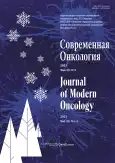Targeted therapy of brain metastases in patients with ALK-positive non-small cell lung cancer: A review
- Authors: Sakaeva D.D.1,2, Bulavina I.S.3
-
Affiliations:
- MD Proekt 2010
- Bashkir State Medical University
- Sitidok-Ural
- Issue: Vol 23, No 4 (2021)
- Pages: 685-694
- Section: CLINICAL ONCOLOGY
- URL: https://journals.rcsi.science/1815-1434/article/view/100131
- DOI: https://doi.org/10.26442/18151434.2021.4.201344
- ID: 100131
Cite item
Full Text
Abstract
The data of recent years indicate the steady increase in the frequency of incidence of brain metastases in many localizations of malignant tumors. Non-small cell lung cancer (NSCLC) is the most common cause, that can affect the central nervous system (CNS). The study of prognostic factors for NSCLC patients with brain metastases, the development of prognostic models, and taking into account the molecular changes can help to approach the development of treatment tactics for this category of patients. The main prognostic factors are age, gender, the Karnofsky’/ECOG status, localization and the number of metastatic foci in the brain, the presence of extracranial metastases, and the histological type of tumor. The discovery of driver mutations and stratification of the cohort of patients with lung adenocarcinoma can open up new potential therapeutic effects in this group of patients, both with primary damage of the CNS and with brain metastases against the background of the therapy. The article deals with the analyzing the literature data and the results of international studies in a group of ALK+ NSCLC patients with brain metastases as well as the mechanisms of lung cancer metastases to the central nervous system and the structure of the blood-brain barrier. The comparative analysis of the treatment of this category of patients using third-generation ALK-inhibitors (alectinib, brigatinib, lorlatinib, crizotinib), the frequency of intracranial response and the possible decision-making algorithm in real clinical practice are presented in detail.
Full Text
##article.viewOnOriginalSite##About the authors
Dina D. Sakaeva
MD Proekt 2010; Bashkir State Medical University
Author for correspondence.
Email: d_sakaeva@mail.ru
ORCID iD: 0000-0003-4341-6017
D. Sci. (Med.), Prof.
Russian Federation, UfaIrina S. Bulavina
Sitidok-Ural
Email: d_sakaeva@mail.ru
Head day hospital
Russian Federation, YekaterinburgReferences
- Preusser M, Capper D, Ilhan-Mutlu A, et al. Brain metastases: pathobiology and emerging targeted therapies. Acta Neuropathol. 2012;123(2):205-22. doi: 10.1007/s00401-011-0933-9
- Fenske DCh, Price GL, Hess LM, et al. Systematic Review of Brain Metastases in Patients With Non-Small-Cell Lung Cancer in the United States, European Union, and Japan. Clin Lung Cancer. 2017;18(6):607-14. doi: 10.1016/j.cllc.2017.04.011
- Tsakonas G, De Petris L, Ekman S. Management of brain metastasized non-small cell lung cancer (NSCLC) – From local treatment to new systemic therapies. Cancer Treat Rev. 2017;54:122-131.
- Rice SR, Bentzen SM, Hanna A, et al. Prognostic models for patients with brain metastases after stereotactic radiosurgery with or without whole brain radiotherapy: a validation study. J Neurooncol. 2018;140(2):341-9. doi: 10.1007/s11060-018-2958-6
- Frega S, Bonanno L, Guarneri V, et al. Therapeutic perspectives for brain metastases in non-oncogene addicted non-small cell lung cancer (NSCLC): Towards a less dismal future? Crit Rev Oncol Hematol. 2018;128:19-29. doi: 10.1016/j.critrevonc.2018.05.013
- Popper HH. Progression and metastasis of lung cancer. Cancer Metastasis Rev. 2016;35:75-91.
- Bickel U. How to Measure Drug Transport across the Blood-Brain Barrier. NeuroRx. 2005;2(1):15-26.
- Li J, Wu J, Bao X, et al. Quantitative and Mechanistic Understanding of AZD1775 Penetration across Human Blood-Brain Barrier in Glioblastoma Patients Using an IVIVE-PBPK Modeling Approach. Clin Cancer Res. 2017;23(24):7454-66. doi: 10.1158/1078-0432.CCR-17-0983
- Смолин А.В., Крюкова Е.В. Принципы лечения метастатического поражения головного мозга при раке легкого. В кн.: Рак легкого. Под ред. К.К. Лактионова, В.В. Бредера. 2-е изд. М., 2020 [Smolin AV, Kriukova EV. Printsipy lecheniia metastaticheskogo porazheniia golovnogo mozga pri rake legkogo. V kn.: Rak legkogo. Pod red. KK Laktionova, VV Bredera. 2-e izd. Moscow, 2020 (in Russian)].
- Mok TSK, Shaw AT, Camidge RD, et al. Final PFS, updated OS and safety data from the randomised, phase III ALEX study of alectinib (ALC) versus crizotinib (CRZ) in untreated advanced ALK+ NSCLC. Poster Discussion – NSCLC, metastatic. Ann Oncol. 2019;30(Suppl_5):v602-v660. doi: 10.1093/annonc/mdz260
- Camidge DR, Kim HR, Ahn M-Ju, et al. Brigatinib Versus Crizotinib in Advanced ALK Inhibitor-Naive ALK-Positive Non-Small Cell Lung Cancer: Second Interim Analysis of the Phase III ALTA-1L Trial. Clin Oncol. 2020;38(31):3592-603. doi: 10.1200/JCO.20.00505
- Miller T, Cudkowicz M, Shaw PJ, et al. Phase 1-2 Trial of Antisense Oligonucleotide Tofersen for SOD1 ALS. N Engl J Med. 2020;383(2):109-19. doi: 10.1056/NEJMoa2003715
- Shaw JA, Guttery DS, Hills A, et al. Mutation Analysis of Cell-Free DNA and Single Circulating Tumor Cells in Metastatic Breast Cancer Patients with High Circulating Tumor Cell Counts. Clin Cancer Res. 2017;23(1):88-96. doi: 10.1158/1078-0432.CCR-16-0825.
Supplementary files

















